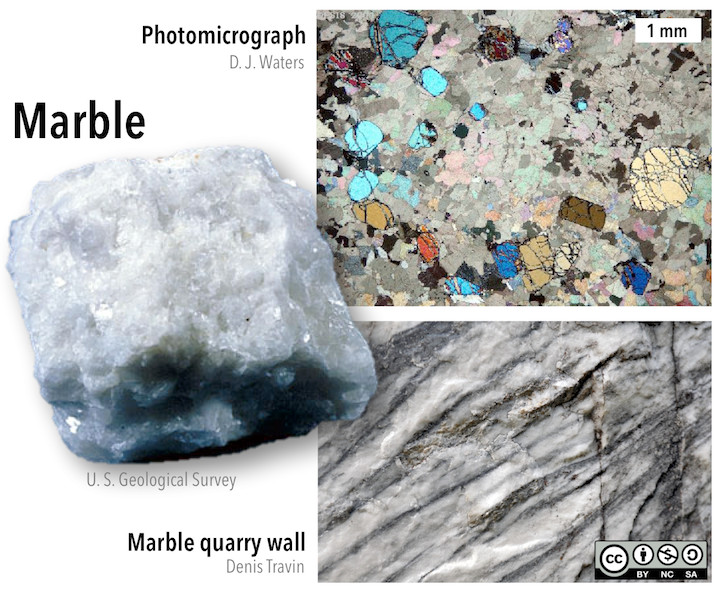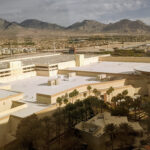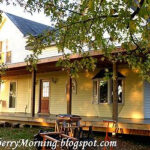Non-foliated metamorphic rocks form primarily through contact metamorphism or when pressure is uniformly applied; let’s explore this geological process and how it shapes the landscapes we see, plus how you can bring the beauty of these rocks to your landscapes with Rockscapes.net.
1. Understanding Non-Foliated Metamorphic Rocks
What exactly are non-foliated metamorphic rocks? How are they different?
Non-foliated metamorphic rocks are types of rocks that lack the layered or banded appearance characteristic of foliated rocks. This distinction arises from their formation process, which typically involves either uniform pressure or the absence of significant directed pressure. As a result, the mineral grains within these rocks do not align in a parallel fashion, leading to a more homogenous, massive appearance.
 Non-foliated metamorphic rock lacks aligned mineral crystals
Non-foliated metamorphic rock lacks aligned mineral crystals
1.1 What Distinguishes Non-Foliated from Foliated Rocks?
The key difference lies in the alignment of mineral grains. Foliated rocks, like slate or gneiss, exhibit a distinct parallel alignment of minerals, often giving them a layered or banded texture. This alignment occurs due to directed pressure during metamorphism. In contrast, non-foliated rocks lack this alignment, resulting in a more uniform appearance.
1.2 What Are the Key Characteristics of Non-Foliated Rocks?
- Lack of Alignment: Mineral grains are randomly oriented.
- Homogenous Texture: Appearance is uniform throughout the rock.
- Equidimensional Grains: Minerals typically have a blocky or granular shape.
- Massive Structure: Rocks appear solid and without distinct layers.
2. The Formation Processes of Non-Foliated Metamorphic Rocks
What are the main ways these rocks come to be?
Non-foliated metamorphic rocks primarily form through two main processes: contact metamorphism and regional metamorphism under specific conditions. Each process involves distinct factors that influence the final rock structure.
2.1 Contact Metamorphism: The Role of Magma
Contact metamorphism occurs when magma intrudes into existing rock formations. The heat from the magma alters the surrounding rocks, causing them to recrystallize. Because the pressure is relatively uniform in this setting, the resulting metamorphic rocks are typically non-foliated.
2.1.1 How Does Proximity to Magma Influence Rock Formation?
The intense heat from magma causes the minerals in the surrounding rock to become unstable and recrystallize into new minerals that are more stable at higher temperatures. This process can transform the original rock into a denser, more durable material without the development of foliation.
2.1.2 What Types of Rocks Are Commonly Formed Through Contact Metamorphism?
Common non-foliated rocks formed through contact metamorphism include:
- Hornfels: A fine-grained rock formed from the metamorphism of shale or mudstone.
- Quartzite: When sandstone is subjected to contact metamorphism it turns into Quartzite.
- Marble: Recrystallized limestone or dolostone.
2.2 Regional Metamorphism: Uniform Pressure Conditions
Regional metamorphism occurs over large areas and is typically associated with mountain-building events. While regional metamorphism often results in foliated rocks due to directed pressure, non-foliated rocks can form if the pressure is uniformly applied from all directions.
2.2.1 How Does Uniform Pressure Affect Mineral Alignment?
When pressure is equal in all directions, mineral grains do not experience the directional stress needed to align. Instead, they recrystallize into a tightly interlocking mosaic of grains, resulting in a non-foliated texture.
2.2.2 What Rock Types Emerge from Regional Metamorphism with Uniform Pressure?
- Some Quartzites: Depending on the pressure conditions.
- Some Marbles: Particularly if the protolith (original rock) is relatively pure and the pressure is uniform.
3. Key Factors Influencing the Formation of Non-Foliated Rocks
What elements are essential for the formation of these rocks?
Several factors play crucial roles in determining whether a metamorphic rock will be foliated or non-foliated. These include the type of pressure, the composition of the parent rock, and the temperature during metamorphism.
3.1 The Significance of Pressure Type (Confining vs. Directed)
- Confining Pressure: Equal in all directions, promotes the formation of non-foliated rocks.
- Directed Pressure: Unequal pressure, leads to the alignment of minerals and the development of foliation.
3.2 The Role of Parent Rock Composition
The original composition of the parent rock significantly influences the type of metamorphic rock that forms. For example, rocks composed primarily of equidimensional minerals like quartz or calcite are more likely to form non-foliated rocks.
3.2.1 How Do Blocky Minerals Contribute to Non-Foliation?
Minerals like quartz and calcite have a blocky shape, meaning they are roughly equal in all dimensions. These minerals do not easily align under pressure, which helps in the formation of non-foliated textures.
3.2.2 What Happens When the Parent Rock Contains Impurities?
Impurities in the parent rock can affect the final appearance of the metamorphic rock. For example, impurities in limestone can result in marbled patterns in marble, adding to its aesthetic appeal for landscaping and design.
3.3 Temperature’s Impact on Recrystallization
Temperature is a critical factor in metamorphism as it drives the recrystallization process. Higher temperatures generally result in larger crystal sizes, which can enhance the visual appeal and durability of non-foliated rocks.
4. Common Types of Non-Foliated Metamorphic Rocks and Their Formation
Let’s examine some specific examples of non-foliated rocks.
Several types of non-foliated metamorphic rocks are commonly found and used in various applications. These include marble, quartzite, and hornfels, each with unique characteristics and formation processes.
4.1 Marble: Metamorphosed Limestone
Marble is a classic example of a non-foliated metamorphic rock, formed from the metamorphism of limestone or dolostone. The recrystallization of calcite or dolomite results in a dense, homogenous rock that is highly valued for its beauty and workability.
4.1.1 How Does Limestone Transform into Marble?
During metamorphism, the calcite crystals in limestone recrystallize, growing larger and interlocking to form a strong, durable rock. Any sedimentary textures or fossils present in the original limestone are typically destroyed in this process.
4.1.2 What Are the Different Varieties of Marble?
Marble comes in a variety of colors and patterns, depending on the impurities present in the original limestone. Pure marble is white, while impurities can create a range of colors, including:
- Marbled Marble: Veins of different colors running through the rock.
- Colored Marble: Shades of green, pink, or black due to mineral inclusions.
4.1.3 Where Can Marble Be Used?
Marble is a great stone for countertops, mosaic and wall tiling, exterior wall cladding and flooring.
 Non-foliated metamorphic rock lacks aligned mineral crystals
Non-foliated metamorphic rock lacks aligned mineral crystals
4.2 Quartzite: Metamorphosed Sandstone
Quartzite is another common non-foliated rock, formed from the metamorphism of sandstone. The quartz grains in sandstone are welded together during metamorphism, creating an exceptionally hard and durable rock.
4.2.1 How Does Sandstone Become Quartzite?
The metamorphism of sandstone involves the recrystallization of quartz grains and the deposition of additional silica, which cements the grains together. This process eliminates the porosity of the original sandstone, resulting in a dense, impenetrable rock.
4.2.2 What Characteristics Define Quartzite?
- High Hardness: Extremely resistant to weathering and erosion.
- Granular Texture: Composed of tightly packed quartz grains.
- Variety of Colors: White, grey, pink, or reddish, depending on impurities.
4.2.3 Where Can Quartzite Be Used?
Quartzite is a great stone for steps, staircases, walkways and patios.
4.3 Hornfels: Contact Metamorphism Product
Hornfels is a fine-grained, non-foliated rock formed through contact metamorphism of shale, mudstone, or volcanic rocks. Its formation near magma intrusions leads to a dense, hard rock with a variable mineral composition.
4.3.1 How Does Hornfels Form Near Magma?
The intense heat from nearby magma causes the minerals in the parent rock to recrystallize into a variety of new minerals, such as micas, pyroxene, and amphibole. The lack of directed pressure results in a random orientation of these crystals.
4.3.2 What Distinguishes Hornfels from Other Non-Foliated Rocks?
- Fine-Grained Texture: Small crystal size due to rapid cooling.
- Variable Composition: Depending on the parent rock and metamorphic conditions.
- Hard and Dense: Resistant to weathering.
5. The Geological Settings for Non-Foliated Rock Formation
Where do these rocks typically form in the Earth’s crust?
Non-foliated metamorphic rocks are found in a variety of geological settings, each characterized by specific conditions that promote their formation.
5.1 Contact Metamorphic Zones: Magmatic Intrusions
Contact metamorphism is most common in areas where magma intrudes into the upper crust. These areas are often associated with volcanic activity and tectonic plate boundaries.
5.1.1 What Geological Features Indicate Contact Metamorphism?
- Intrusive Igneous Rocks: Presence of granitic or basaltic intrusions.
- Altered Country Rock: Visible changes in the surrounding rock formations.
- Mineral Veins: Deposits of minerals precipitated from hydrothermal fluids.
5.1.2 Examples of Contact Metamorphic Regions
- The Sierra Nevada, USA: A region with extensive granitic intrusions and associated contact metamorphism.
- The Scottish Highlands, UK: Known for its complex geology and numerous contact metamorphic zones.
5.2 Regional Metamorphic Terrains: Uniform Pressure Zones
Regional metamorphism typically occurs in areas undergoing mountain-building events. While directed pressure is common in these settings, some zones experience more uniform pressure, leading to the formation of non-foliated rocks.
5.2.1 What Tectonic Settings Favor Uniform Pressure?
- Areas of Crustal Thickening: Where the crust is compressed equally from all directions.
- Stable Continental Interiors: Regions that have not experienced significant deformation in a long time.
5.2.2 Examples of Regional Metamorphic Terrains with Non-Foliated Rocks
- The Canadian Shield, Canada: A large area of ancient rocks with evidence of regional metamorphism under uniform pressure.
- The Adirondack Mountains, USA: A region with complex metamorphic history and zones of non-foliated rock formation.
6. Why Use Non-Foliated Metamorphic Rocks in Landscapes?
Let’s find out why these stones are loved by homeowners in the USA.
Non-foliated metamorphic rocks offer numerous benefits in landscaping due to their durability, aesthetic appeal, and versatility. From creating striking focal points to providing functional elements, these rocks enhance any outdoor space.
6.1 Durability and Longevity
- Weather Resistance: Resistant to weathering, erosion, and freeze-thaw cycles.
- Low Maintenance: Requires minimal upkeep, saving time and resources.
- Long-Lasting: Maintains its appearance and structural integrity for years.
6.2 Aesthetic Versatility
- Variety of Colors and Textures: Complements any design style, from rustic to contemporary.
- Natural Beauty: Enhances the visual appeal of gardens, pathways, and water features.
- Unique Character: Adds a distinctive touch to any landscape project.
6.3 Functional Applications
- Pathways and Walkways: Provides stable and attractive surfaces for pedestrian traffic.
- Retaining Walls: Offers structural support and prevents soil erosion.
- Water Features: Creates stunning waterfalls, ponds, and stream beds.
- Garden Accents: Serves as decorative elements, adding interest and texture to planting beds.
7. Landscape Design Ideas with Non-Foliated Rocks
Where can you apply these rocks for your home?
Non-foliated rocks can be incorporated into a variety of landscape designs to create visually appealing and functional outdoor spaces. Here are some inspiring ideas:
7.1 Creating Rock Gardens
Rock gardens are a perfect way to showcase the natural beauty of non-foliated rocks. Combine different sizes and colors of rocks to create a dynamic and textured landscape.
7.1.1 How to Choose the Right Rocks for a Rock Garden?
- Select a Variety of Sizes: Use a mix of large boulders and smaller stones.
- Consider Color Harmony: Choose rocks with complementary colors.
- Incorporate Native Plants: Add plants that thrive in rocky environments.
7.1.2 Step-by-Step Guide to Building a Rock Garden
- Plan the Layout: Sketch out the design and placement of rocks.
- Prepare the Soil: Ensure good drainage by adding gravel and sand.
- Place the Boulders: Position the largest rocks first, using machinery if needed.
- Add Smaller Stones: Fill in the gaps with smaller rocks and gravel.
- Plant Vegetation: Choose plants that complement the rocks and thrive in the local climate.
7.2 Designing Water Features
Non-foliated rocks are ideal for creating stunning water features, such as waterfalls, ponds, and stream beds. Their durability and natural appearance enhance the beauty of any water-based landscape.
7.2.1 How to Build a Waterfall with Non-Foliated Rocks
- Select the Rocks: Choose flat, stable rocks for the waterfall structure.
- Create a Foundation: Build a solid base using gravel and compacted soil.
- Position the Rocks: Arrange the rocks to create a natural-looking cascade.
- Install a Pump: Place a submersible pump in the pond to circulate water.
- Add Plants: Incorporate aquatic plants to enhance the water feature.
7.2.2 Tips for Creating a Natural-Looking Pond
- Use a Flexible Liner: Choose a durable liner to prevent leaks.
- Incorporate Varying Depths: Create shallow and deep areas for different plants and wildlife.
- Add a Filtration System: Maintain water quality with a biological filter.
- Edge the Pond with Rocks: Blend the pond seamlessly into the surrounding landscape.
7.3 Constructing Pathways and Walkways
Non-foliated rocks can be used to create durable and attractive pathways and walkways. Their stability and natural appearance make them a great choice for high-traffic areas.
7.3.1 How to Lay a Stone Pathway
- Prepare the Base: Excavate the pathway and add a layer of compacted gravel.
- Choose the Stones: Select flat, evenly sized stones for a smooth surface.
- Position the Stones: Arrange the stones tightly together, leaving minimal gaps.
- Fill the Gaps: Add sand or gravel between the stones to stabilize them.
- Compact the Surface: Use a plate compactor to ensure the pathway is level and firm.
7.3.2 Ideas for Incorporating Stone into Walkways
- Random Stone Patterns: Create a natural look with irregularly shaped stones.
- Formal Stone Pathways: Use uniform stones for a polished appearance.
- Gravel and Stone Combinations: Combine gravel and stone for a textured pathway.
8. Sourcing and Selecting Non-Foliated Metamorphic Rocks
Where can homeowners get these rocks?
Choosing the right non-foliated rocks for your landscaping project involves considering several factors, including the type of rock, its color, size, and availability.
8.1 Identifying Quality Rocks
- Check for Durability: Ensure the rocks are free from cracks and weaknesses.
- Assess the Color and Texture: Select rocks that complement your landscape design.
- Consider the Size and Shape: Choose rocks that fit the scale and purpose of your project.
8.2 Finding Local Suppliers
- Rock Yards: Visit local rock yards to view a wide selection of rocks.
- Quarries: Source rocks directly from quarries for larger projects.
- Landscape Suppliers: Purchase rocks from landscape suppliers for convenience.
8.3 Budget Considerations
- Compare Prices: Get quotes from multiple suppliers to find the best deal.
- Factor in Delivery Costs: Consider the cost of transporting the rocks to your site.
- Prioritize Quality: Invest in durable rocks to avoid costly replacements in the future.
9. The beauty of Rocks and the Strength of Rockscapes.net
Why should homeowners choose rockscapes.net?
At Rockscapes.net, we understand the unique appeal and versatility of non-foliated metamorphic rocks. Our team of experts is dedicated to helping you find the perfect stones for your landscaping projects, ensuring exceptional quality and customer satisfaction.
9.1. Extensive Selection
Rockscapes.net offers an extensive selection of non-foliated rocks. Whether you’re looking for the timeless elegance of marble, the rugged durability of quartzite, or the unique character of hornfels, we have the perfect stones to bring your vision to life.
9.2. Expert Guidance
Selecting the right stones can be overwhelming, which is why our knowledgeable team is here to guide you every step of the way. From helping you choose the ideal rock types to providing design inspiration and installation tips, we’re committed to making your landscaping journey seamless and enjoyable.
9.3. Quality Assurance
At Rockscapes.net, we prioritize quality above all else. We source our rocks from reputable quarries and suppliers, ensuring that every stone meets our rigorous standards for durability, aesthetics, and sustainability.
9.4. Inspiring Design Ideas
Explore our gallery of stunning landscape designs featuring non-foliated metamorphic rocks. From serene rock gardens to captivating water features, discover endless possibilities for transforming your outdoor space into a haven of natural beauty.
10. FAQs About Non-Foliated Metamorphic Rocks
Here are some frequently asked questions about non-foliated metamorphic rocks:
- 1. What is the main difference between foliated and non-foliated metamorphic rocks?
- Foliated rocks have aligned mineral grains, giving them a layered appearance, while non-foliated rocks have randomly oriented grains.
- 2. How does contact metamorphism lead to the formation of non-foliated rocks?
- The heat from magma causes recrystallization without directed pressure, resulting in a non-foliated texture.
- 3. What are some common examples of non-foliated metamorphic rocks?
- Marble, quartzite, and hornfels are common examples.
- 4. What type of rock is marble formed from?
- Marble is formed from the metamorphism of limestone or dolostone.
- 5. Why is quartzite so durable?
- The quartz grains are tightly welded together during metamorphism, creating a dense, hard rock.
- 6. What is hornfels, and how is it formed?
- Hornfels is a fine-grained rock formed by contact metamorphism of shale, mudstone, or volcanic rocks.
- 7. In what geological settings are non-foliated rocks typically found?
- They are found in contact metamorphic zones near magmatic intrusions and in regional metamorphic terrains with uniform pressure.
- 8. How can non-foliated rocks be used in landscape design?
- They can be used in rock gardens, water features, pathways, and retaining walls.
- 9. What factors should be considered when selecting rocks for a landscaping project?
- Durability, color, texture, size, and availability should be considered.
- 10. What are the benefits of using non-foliated rocks in landscaping?
- They are durable, aesthetically versatile, and functional, enhancing the beauty and value of outdoor spaces.
Ready to transform your outdoor space with the timeless beauty and durability of non-foliated metamorphic rocks? Visit rockscapes.net today to explore our extensive selection, get expert advice, and discover inspiring design ideas. Let us help you create a landscape that reflects your unique style and stands the test of time.

